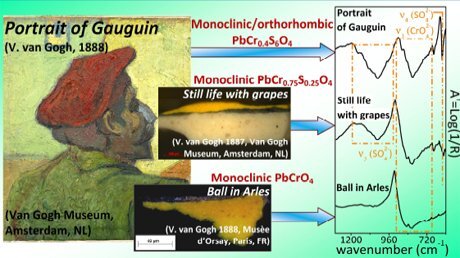The darkening of chrome yellow is a phenomenon widely observed on several paintings by Vincent van Gogh such as the famous versions of the Sunflowers. Analysis of artificially aged model samples of lead chromate using the combined use of various synchrotron radiation based analytical techniques (μ-XRD, μ-XANES and µ-FTIR), established that darkening of chrome yellow is caused by reduction of PbCrO4 to Cr2O3.2H2O (viridian green). This is likely accompanied by the presence of another Cr(III) compound, such as either Cr2(SO4)3.H2O or (CH3CO2)7Cr3(OH)2 [chromium(III) acetate hydroxide]. In the second part of this work, original paint samples from two Van Gogh paintings were studied to confirm that this reduction phenomenon actually takes place in historical paintings.

The third part of our study aimed at differentiating various types of chrome yellow in the work of Van Gogh while the fourth part explored the relation between the sulfate content, the crystal form and the susceptibility to darkening ageing of the different pigment types.The results demonstrated that the exact nature of chrome yellow strongly influences its long-term stability. For this reason, future work will assess the correlation between the pigment composition/crystalline structure and its state of preservation in historical paintings.